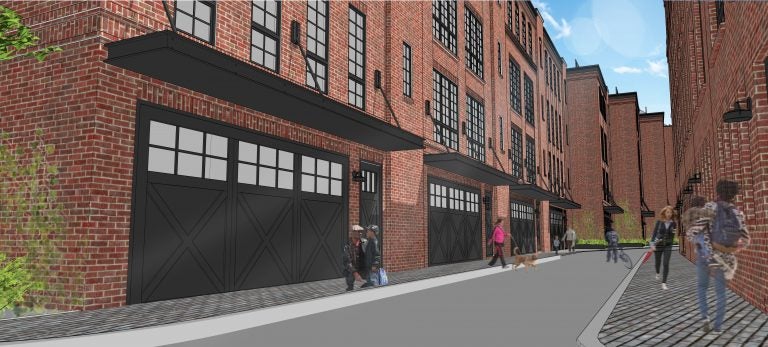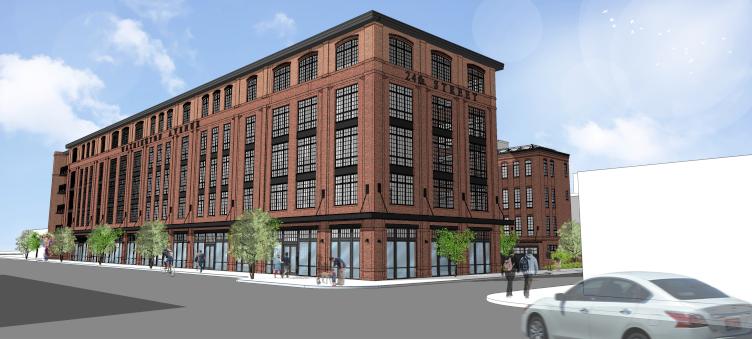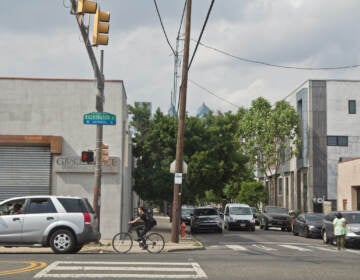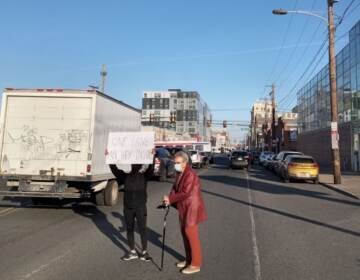How a Philly neighborhood negotiated with a developer and won
A major new residential development planned with social impact in mind will soon break ground on fast-changing Washington Avenue.

A rendering that shows the 2401 Washington Ave. from 24th Street looking west into an interior driveway. (Noah Ostroff)
This article originally appeared on PlanPhilly.
—
A major new residential development planned with social impact in mind will soon break ground on fast-changing Washington Avenue.
The project at 2401 Washington Ave. will be one of a few new Philadelphia developments built with a community benefits agreement at its foundation. The agreement, signed by the developer, Noah Ostroff of Philly Living, and the South of South Neighborhood Association (SOSNA), played a key role in fostering neighborhood support for the project, which will bring 80 new homes and 8,000 feet of retail to an industrial lot.
SOSNA negotiated with Ostroff and his partner Michael Murray for months prior to the CBA’s signing and the subsequent introduction of a rezoning bill by City Councilman Kenyatta Johnson. The legislation was needed for the project to advance without a visit to the Zoning Board of Adjustment.
“It’s the culmination of years of feedback and input that we’ve received around what residents want to see on Washington Avenue,” said David Zega, chairman of SOSNA. “It provides a lot of great things. Local hiring, neighborhood amenities, and most importantly workforce housing that will allow more people to have access to the resources and the community.”
Ostroff’s development includes a mix of townhomes, duplexes, and multi-family apartments along with shops fronting on Washington. Fifty-four of the homes will be rentals and 26 for sale, divided roughly equally between one-bedroom, two-bedroom and three-bedroom units
The CBA stipulates that the developer reserve eight units — 10 percent of the total— to rent out for 60% of the area median income. According to this formula, a one-bedroom apartment would rent for $1,048, the developer said.
80 new homes, no bay windows
The buildings, clad in traditional red brick, speak to the corridor’s evolving identity, evoking its industrial past while advancing its move towards a residential future. Washington runs through two of Philadelphia’s hottest neighborhoods, demarcating a dividing line separating southwest Center City and redeveloping South Philadelphia.
“We wanted the architecture to be different, because I’m really drawn to old industrial buildings,” Ostroff said, citing a project that he built at 13th and Reed Streets in South Philadelphia that attempts to create the look and feel of an old, brickclad warehouse. (The structure caught the eye of Philadelphia Inquirer architecture Inga Saffron, who devoted a column to it.) The two projects share the same architects: Agata Reister and Vincent Mancini of Landmark Architecture.
Johnson introduced the rezoning on the same day as a bill that would ban bay windows and balconies from Point Breeze and Grays Ferry, within days of winning another term as Councilman. Renderings of the 2401 Washington Ave. development do not show any bay windows or balconies.
The 2401 Washington Ave. bill is a classic example of what is called spot zoning, a legally dubious but relatively common practice where a legislator will change the zoning map for a parcel of land to allow one particular project to move forward.
Johnson attributed much of the contents of SOSNA’s community benefits agreement to his strategy for preserving the antiquated zoning of Washington Avenue.
“The … affordable component, and local hiring that are significant parts of this development now would not have happened with a by-right build,” wrote Johnson in an email. “This is a model project that speaks to the power of a community engagement process to create better projects that are responsive to community needs, inclusive, and equitable.”
The jobs promise included in the CBA commits the developer to include a provision in commercial leases requiring that up to 30% of employees live in the project’s 19146 zip code and others adjoining it.
The CBA also includes a 35% commitment to minority, women, or disabled-owned contractors, and a commitment that 20% of commercial tenant space will go to firms owned by these groups.
It also offers more prosaic promises, like placing Big Belly trash cans on nearby intersections, planting street trees, and offering a design aesthetic that matches the neighborhood’s historic built environment. The buildings will rise no higher than five stories.
“It was a pretty smooth process we got a lot of good feedback and people are generally supportive of the project,” Ostroff said. “We just agreed to everything SOSNA wanted because it was mostly what we wanted to do with the project anyway, with a couple of small additions.”

‘A model for other communities’
Neighbors and business owners have long clashed over the future of Washington Avenue. Some longtime residents have fought to keep new housing development away from the corridor, which they see as a potential source of jobs at warehouses and other commercial businesses.
But while most manufacturing has left the area, remaining warehouses and wholesalers increasingly find themselves operating in a more residential area, where neighbors want more street trees and fewer honking delivery trucks.
Councilman Kenyatta Johnson argues that the live debate over how to best keep businesses on the corridor indicates a need to retain the industrial zoning in the area, rather than follow the rezoning recommendations of city planning experts and many neighbors.
By keeping the old industrial maps that overlay Washington Avenue, Johnson ensures that developments like Ostroffs will have to meet with the community — and the Councilman — before requesting a zoning waiver from the city’s Zoning Board of Adjustment or remapping legislation from Johnson himself. The groups also have the opportunity to make their voice heard at the ZBA hearing itself and at mandatory community meetings beforehand, giving them leverage over development.
There are stark limits to the leverage that the old industrial zoning gives neighborhood groups. Just down the street, SOSNA hasn’t successfully reached a community benefits agreement with Ori Feibush at the site of his large block long project to redevelop the site of the old Frankford Chocolate Factory.
For his part, SOSNA’s Zega said he believes they could have reached a community benefits agreement with Ostroff even if Washington Avenue was remapped to allow for residential development. He emphasized, too, how important it was to have a willing developer like Ostroff to deal with on the neighborhood group’s first community benefits agreement.
“This is not only a model for Washington Avenue but for what other communities can do in other areas of the city as well,” said Zega.
WHYY is your source for fact-based, in-depth journalism and information. As a nonprofit organization, we rely on financial support from readers like you. Please give today.







